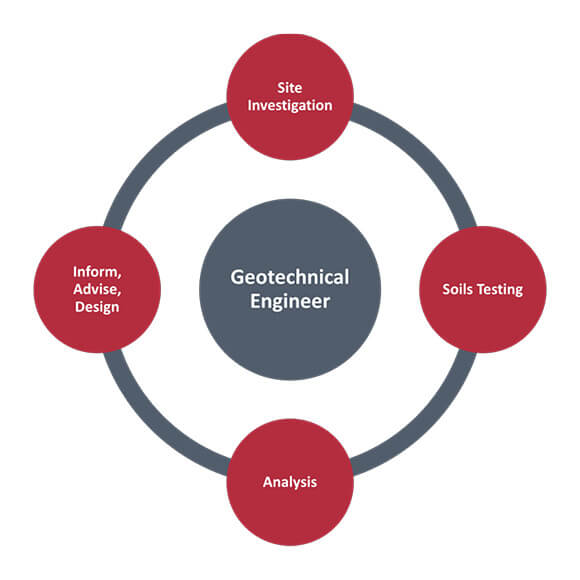Geotheta Things To Know Before You Buy
Geotheta Things To Know Before You Buy
Blog Article
Getting The Geotheta To Work
Table of ContentsGeotheta - The FactsWhat Does Geotheta Do?Excitement About GeothetaFascination About Geotheta8 Simple Techniques For Geotheta

They conduct site investigations, gather samples, do laboratory tests, and assess data to examine the viability of the ground for construction projects - Geo Tech Engineer. Based upon their findings, geotechnical engineers give referrals for structure style, incline security, keeping structures, and reduction of geotechnical dangers. They team up with various other experts, such as designers, architectural designers, and building and construction groups, to make certain that geotechnical considerations are incorporated right into the total job style and application
By assessing the habits and residential properties of dirt and rock, they can recognize prospective geotechnical risks such as landslides, soil negotiation, or incline instability. Their knowledge aids protect against failings or accidents that can jeopardize lives and residential property. Right here are some in-depth tasks and responsibilities of a geotechnical engineer: Website Investigation: Geotechnical engineers conduct site investigations to gather information on subsurface problems.
They interpret the information to comprehend the buildings and actions of the dirt and rock, including their strength, permeability, compaction attributes, and groundwater problems. Geotechnical Evaluation and Design: Geotechnical designers analyze the data gathered during site investigations to examine the stability and suitability of the website for construction projects. They do geotechnical estimations and modeling to review variables such as birthing ability, negotiation, slope stability, lateral earth stress, and groundwater flow.
The 20-Second Trick For Geotheta
Foundation Layout: Geotechnical designers play an essential duty in creating foundations that can safely support the desired structure. They analyze the soil conditions and lots demands to figure out the proper foundation kind, such as superficial foundations (e.g., grounds), deep structures (e.g (https://es.quora.com/profile/Ian-Hammond)., piles), or specialized techniques like dirt enhancement. They take into consideration elements such as settlement limits, birthing ability, and soil-structure interaction to create ideal foundation styles
They examine building plans, screen site activities, and conduct area examinations to validate that the design referrals are followed. If unexpected geotechnical issues arise, they examine the circumstance and provide referrals for remediation or adjustments to the style. Risk Evaluation and Mitigation: Geotechnical designers examine geotechnical hazards and dangers related to the project site, such as landslides, liquefaction, or dirt disintegration.

Cooperation and Interaction: Geotechnical engineers work very closely with other experts associated with a project, such as architects, architectural designers, and building groups. Reliable interaction and cooperation are vital to incorporate geotechnical factors to consider right into the overall task style and construction process. Geotechnical designers give technical experience, answer questions, and guarantee that geotechnical requirements are fulfilled.
Getting My Geotheta To Work
Right here are some kinds of geotechnical designers: Foundation Engineer: Foundation engineers concentrate on developing and examining structures for frameworks. They assess the soil problems, load demands, and website qualities to figure out one of the most suitable structure kind and design, such as shallow foundations, deep foundations, or specialized techniques like pile foundations.
They review the factors influencing incline security, such as dirt residential or commercial properties, groundwater conditions, and slope geometry, and establish techniques to stop incline failings and mitigate risks. Earthquake Engineer: Earthquake engineers focus on examining and designing frameworks to hold up against seismic pressures. They analyze the seismic risk of a site, review dirt liquefaction potential, and create seismic design criteria to make sure the safety and security and durability of structures during earthquakes.
They carry out area testing, accumulate examples, and examine the accumulated data to define the dirt residential or commercial properties, geologic formations, and groundwater conditions at a site. Geotechnical Instrumentation Engineer: Geotechnical instrumentation designers concentrate on tracking and measuring the behavior of dirt, rock, and structures. They mount and keep instrumentation systems that check aspects such as soil settlement, groundwater degrees, slope movements, and architectural displacements to evaluate performance and supply early warnings of potential concerns.
8 Simple Techniques For Geotheta
They conduct tests such as triaxial examinations, combination examinations, straight shear tests, and leaks in the structure examinations to collect data for geotechnical analysis and style. Geosynthetics Designer: Geosynthetics designers concentrate on the style and application of geosynthetic products, such as geotextiles, geogrids, and geomembranes. They utilize these materials to improve soil security, reinforce inclines, provide drainage services, and control erosion.
They often tend to be investigatory people, which indicates they're intellectual, introspective, and investigative. They wonder, methodical, sensible, logical, and rational. Some of them are also social, implying they're kind, charitable, participating, client, caring, helpful, empathetic, skillful, and friendly. Does this noise like you? Take our free career examination to learn if geotechnical designer is one of your top job matches.
In the workplace setting, geotechnical designers use specialized software program devices to execute estimations, produce styles, and evaluate data. They prepare records, evaluation task specs, communicate with clients and employee, and coordinate task tasks. The office setup gives a favorable setting for research study, analysis, and partnership with various other experts involved in the task.
The Greatest Guide To Geotheta
They regularly check out project websites to perform site examinations, examine geotechnical problems, and collect information for analysis. These check important site outs involve traveling to various places, sometimes in remote or difficult surfaces. Geotechnical designers may carry out dirt sampling, conduct examinations, and screen construction activities to make sure that the geotechnical aspects of the job are being carried out correctly.
Geotechnical designers also operate in specialized geotechnical labs. In these centers, they perform experiments, perform tests on dirt and rock examples, and evaluate the engineering residential properties of the products. Geotechnical laboratory designers work extensively in these settings, handling testing devices, running tools, and videotaping data. They collaborate with other laboratory personnel to make certain exact and dependable testing outcomes.
Report this page